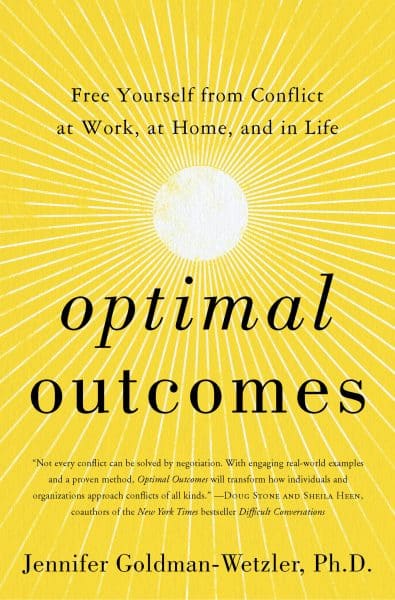The Financial Times Business Book of the Month

People tell me they often appreciate my book reviews since I’ve taken some of the legwork out of it for them to find both interesting and helpful reads.
This month I’m focusing on one book in particular: Optimal Outcomes: Free Yourself from Conflict at Work, at Home, and in Life. This book was recently named Business Book of the Month by The Financial Times.
 Full disclosure: I know the author Jen Goldman, who’s awesome, and have participated in facilitating some of her work, detailed in the book, in a multi-day workshop so I’ve seen live and in person how transformative this work can be for people.
Full disclosure: I know the author Jen Goldman, who’s awesome, and have participated in facilitating some of her work, detailed in the book, in a multi-day workshop so I’ve seen live and in person how transformative this work can be for people.
The book is formally in bookstores near you, and of course Amazon, February 25th, 2020.
Jen’s book “Optimal Outcomes” is a manual for how you can resolve any conflicts that you are a part of, even if it’s a long-standing conflict where people have become deeply entrenched in their positions. And even whether or not the other person is willing to work with you.
Since I’m “in the know,” Jen gifted me with an advance copy of her book before our winter holiday trip to Mexico. Usually I try to save my vacation reading time for fun fiction that I’ve been dying to read but haven’t had time for. I’ve been very familiar with Jen’s work so I made an exception this year since I really wanted to read Jen’s book. I was curious to see how she could take this work that I’ve seen in workshop form, and translate the insights into a book. What was both surprising and pleasant to me was how engrossed I was reading this book by the beach in Mexico. I literally wanted to keep reading this book and learning all the tools detailed in the book.
 Although I’ve seen a lot of this conflict resolution work in Jen’s workshop, I actually found that the book made it much easier for me to internalize all the different steps and understand the process through which you can work through any long standing conflict that you have with someone in your life. I love that you can keep coming back to, and getting better at the main tools as you revisit the book for any new situations that arise.
Although I’ve seen a lot of this conflict resolution work in Jen’s workshop, I actually found that the book made it much easier for me to internalize all the different steps and understand the process through which you can work through any long standing conflict that you have with someone in your life. I love that you can keep coming back to, and getting better at the main tools as you revisit the book for any new situations that arise.
In this book, there’s one main story that Jen tells in pieces and returns to throughout the book. And this one story about Bob and Sally is so compelling, you honestly want to keep reading to find out what happens to Bob and Sally; how do they actually resolve their initial conflict as well as the fallout from that period of conflict? There are several other mini stories that illustrate points throughout the book, but I found myself most absorbed trying to understand out how Bob and Sally would navigate their differences.
Most negotiation books, like “Getting to Yes,” or “Never Split The Difference: Negotiating As If Your Life Depended On It,” (which is actually a really great additional book to complement this one) assume you’re negotiating with someone else.
Unlike those books, Optimal Outcomes doesn’t require that you get the consent of someone else to work together with you. This is really a book about how you work with yourself, to come up with different alternatives, and different ways of being with this conflict to eventually change the conflict you’re in. And then, if and only if it’s the right decision, you can start creating scenarios where you involve the other person or other people and think about how to do that productively. What’s really unique about Jen’s work, is it first focuses on what you yourself can do and where you can take action and be in control of any conflicts that you’re a part of, yet are unhappy that they still remain in your life.
In the book, Jen gives 8 separate practices. One of the most useful practices, Practice 2, Jen describes one way to increase clarity is to “map out your conflict.” What I love about this, and I’ve actually used this practice since learning it several times with clients, is that usually we see conflict as what’s not working well between us and one other person; we ignore all the other forces and people that are actually involved in the conflict, whether they appear to be or not at first glance. This practice helps you to to visualize the whole situation so you can recognize a lot of the underlying forces that are putting pressure both on you and on the person or people that you’re at odds with. You can begin to see your conflict within the larger system as opposed to just feeling it’s about one relationship or set of relationships; especially long-standing conflict is usually about a lot more.
My second favorite practice, practice 6, details how to design a pattern-breaking path. The idea behind this, and much of the book, is that if this is a long-standing conflict, you’ve probably already tried many tacks, and none of those have worked. This practice describes how to design and try new things instead of doing your same old things that haven’t been working and then beating your head up against the wall. It helps you create innovative approaches where before there was only frustration.
There’s so much more to love about this book. There are a lot of books that I read and think, “Oh, this can be good for this type of person in this type of situation.” And this is really one of the few books I’ve read where I think, “Wow! Everyone needs to read this!” All of us have something like this in our lives, whether it’s top of mind or perhaps a hidden undercurrent. Jen’s practices are not just for one or two long standing conflicts, they are important tools to learn and practice over and over in your life; they will change how you deal with people in a long term, significant way that’s truly transformational.
So please, please buy this book! And if you’re going to buy this book, please buy it very soon! What I’ve learned about publishing is that it’s best to buy it in before it’s released because pre orders really dictate how well a book does overall. That’s why if you do buy it, send your receipt to Jen (details on her website ) for some additional pre-order bonuses. Once you buy and read it, please share what you thought of it with me as well.
Just a quick PS, I get absolutely no money or anything from you buying this book, not from Amazon or anyone else. I’m only recommending it because I think it’s an amazing resource.